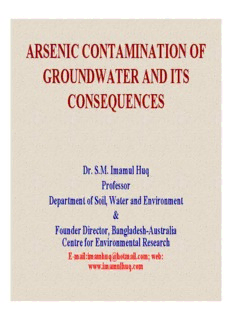
ARSENIC CONTAMINATION OF GROUNDWATER AND ITS PDF
Preview ARSENIC CONTAMINATION OF GROUNDWATER AND ITS
ARSENIC CONTAMINATION OF GROUNDWATER AND ITS CCOONNSSEEQQUUEENNCCEESS Dr. S.M. Imamul Huq Professor Department of Soil, Water and Environment & Founder Director, Bangladesh-Australia Centre for Environmental Research E-mail:imamhuqq@@hotmail.com;; web: www.imamulhuq.com Backgground (cid:137) Arsenic contamination of ground water was first reported eeaarrllyy 11999900ss As affected patient was thought to be having some kind of (cid:137) skin diseases. DCH identified – Diseases caused byy As inggestion (cid:137) Problem of As is new, Although As has been present in GW (cid:137) ffoorr tthhoouussaanndd ooff yyeeaarrss OOrriiggiinn ooff AAss iinn GGrroouunndd wwaatteerr (cid:137)(cid:137) BBotthh AAntthhropogeniic andd GGeogeniic source Source of As in Bangladesh soil - Alluvial in nature (cid:137) Contamination occurs in GW from Alluvial and Deltaic (cid:137) sediments “Likely source of As in GW : Geogenic” • Arsenic - Originates from the Greek word – aarrsseenniiccoonn –ppootteenntt • Known since 340 BC •• UUsseess:: DDrruugg oorr ppooiissoonn –hhoommiicciiddaall mmuurrddeerrss;; pigments, insecticides, herbicides, defoliants, alloyy in metals,, chemical warfare aggents,, wood preservatives etc. • Occurrence: • in air – 0.005 to 0.1 µg/m3 • in water less than 10 µg/l • in soil less than 15 mg/kg • in food less than 0.1 mg/kg • 10-20 fold increases in As levels above this bbackkgroundd concentratiion may resullt ffrom industrial and agricultural inputs • AAnntthhrrooppooggeenniicc ssoouurrcceess ooff eennvviirroonnmmeennttaall AAss contamination – fossil-fuelled power plants; smelting of lead, copper, zinc, and gold ores; aaggrriiccuullttuurraall uussee ooff aarrsseenniiccaall hheerrbbiicciiddeess aanndd pesticides • Globally → 48,000 m t As/yr • +5 or arsenate: AsO -3, HAsO -2, H AsO - → oxygen 4 4 2 4 rich acidic condition • ++33 oorr aarrsseenniittee:: AAss((OOHH)) , AAss((OOHH)) -, AAss OO OOHH-2, 33 44 22 22 AsO -3 → moderately reducing anaerobic 3 environment like ground water Guideline values for As in drinking water Countryy/orgganization max. contaminant level((CML)) µµgg/L Australia 7 Canada 25 USEPA 20 (50) France 50 Germany 1 WHO 10 EEEECC 1100 India 50 China 50 TTaaiiwwaann 5500 Bangladesh 50 Food Crops – 50 ppb • Toxicity: deopends on : i. Oxidation states iiii.. CChheemmiiccaall ffoorrmm iii. Solubility in the biological system • arsine > inorganic As (III) > organic As (III) > inorganic As (V) > organic As (V) > arsonium compounds and elemental arsenic • aarrsseenniittee iiss 6600 xx mmoorree ttooxxiicc tthhaann aarrsseennaattee wwhhiicchh iiss 7700 xx mmoorree toxic than methylated species, monomethyl arsonic acid (MMAA) and dimethyl arsinic acid • Tolerable daily intake (TDI): amount of substance/kg body wt. ingested daily over a life time without health risk – estimated risk ((based on 60 kgg pperson drinkingg 2L/dayy,, for a life of 70 years) →0.17 µg/L for practical purpose → 10 µg/L • Global problem: Argentina, Alaska, Chile, China, Mongolia, HHungary, IInddiia, MMexiico, TThhaiillandd, CCambboddiia, UUSSAA IInnggeessttiioonn ooff aarrsseenniicc iiss mmaanniiffeesstteedd iinn tthhrreeee manners in human beings: • As in urine (recent exposure) • As in blood (for instant exposure) • As in skin, hair and finger nails (for chronic expposure)) Possible pathways of As ingestion by human Fish INGESTION Eggs, Meat, Milk Fish food Plants Animals Drinking water Soil water Soil Food chain Gills Cooking Algae As in tubewell Irrigation RRuunn ooffff ttoo ffiisshh ppoonnddss As in sediment Erosion from Himalayas
Description: